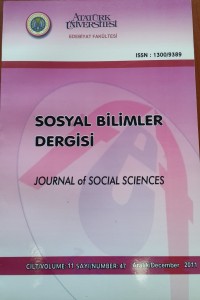Abstract
Gaining a reputation of a marginalised figure, Naipaul is popularised as a writer of cultural displacement, who is in a perpetual state of exile. The problems of individuals struggling to establish and maintain their integrity as independent people, and the lack of construction of a historical and national consciousness, naturally and quite significantly are the prevailing issues of a writer who has grown up in the colonial atmosphere of Trinidad. Naipaul’s personal displacement as a homeless figure is so much continually re-enacted in his works and so much celebrated that he seems to be taking a literary advantage as a marginalised figure
who is re-pushed into the centre of public attention as twentieth century writer.
The Mimic Men published in 1967 deals with the damaging effects of the absence
of a regional, historical and cultural consciousness. Therefore, the representation
of mimicry, cultural displacement and exile in The Mimic Men will be the major
concentration of this paper.
Keywords
References
- Bhabha, Homi. “Of Mimcry and Man” Ed. Homi Bhabha . Location of Culture. London: Routledge, 1994. 85-92.
- Cabral, Amilcar. “National Liberation and Culture” Eds. Patrick Williams and L. Chrisman. Colonial Discourse and Post-Colonial Theory: A Reader. New York: Columbia UP, 1994. 53-65.
- Dabydeen, David. The Black Presence in English Literature. Manchester, UK: Manchester UP, 1985.
- Fanon, Frantz. “On National Culture” Eds. Patrick Williams and L. Chrisman. Colonial Discourse and Post-Colonial Theory: A Reader. New York: Columbia UP, 1994. 36-52.
- Greenberg, Robert M. “Anger and the Alchemy of Literary Method in V.S. Naiapul’s Political Fiction: The Case of the Mimic Men” Twentieth Century Literature. 46.2. (2000): 214-238.
- Ivison, Duncan. Postcolonial Liberalism. Cambridge UP, 2002.
- King, Bruce. V.S. Naipaul. London: Macmillan, 1993.
- Naipaul, V.S. The Mimic Men. New York: Vintage, 1995.
- Nightingale, Peggy. Journey Through Darkness: The Writing of V.S. Naipaul. London: Queensland UP, 1987.
- Nixon, Rob. London Calling: V.S. Naipaul, Postcolonial Mandarin . New York: Oxford UP, 1992.
- Said, Edward. Culture and Imperialism. London: Vintage, 1994.
- Weiss, Timothy. On the Margins: The Art of Exile in V.S. Naipaul. Massachusetts: Massachusetts UP, 1992.
- Wheeler, Charles. “V.S. Naipaul on India”. Ed. Froza Jussawalla. Conversations with V.S. Naipaul Mississippi: Mississippi UP, 1997. 39-44.
Naipaul’un The Mimic Men (Taklitçiler) Adlı Eserindeki Taklitçilik, Kültürel Yer Değişim ve Sürgün Kavramları
Abstract
Marjinal kişiliğiyle tanınan Naipaul, hayat boyu sürgünlük ve kültürel yer değişim kavramlarıyla ünlenen bir yazar olmuştur. Trinidad’ın coloni atmosferinde yetişen yazar, insanların özgür bireyler olarak bütünlüklerini koruma çabalarını tarihi ve ulusal bilinç eksikliğini eserlerine konu etmiştir. Naipaul evsiz bir kişilik olarak yer değişime ve kültürel kaymaya eserlerinde o kadar fazla yer vermiştir ki, bundan edebi çıkar sağlar gibi görünmüştür ve marjinal bir kişilik olmasına rağmen, ilgi odağı olmayı başarmıştır. 1967’de yayınlanan The Mimic Men (Taklitçiler), bölgesel, tarihi ve kültürel bilinç eksikliğinin yok edeci etkilerini incelemektedir. Bu nedenle, Naipaul’un The Mimic Men (Taklitçiler) adlı eserindeki taklitçilik, kültürel kayma ve sürgün kavramları bu çalışmanın temel amacı olacaktır.
References
- Bhabha, Homi. “Of Mimcry and Man” Ed. Homi Bhabha . Location of Culture. London: Routledge, 1994. 85-92.
- Cabral, Amilcar. “National Liberation and Culture” Eds. Patrick Williams and L. Chrisman. Colonial Discourse and Post-Colonial Theory: A Reader. New York: Columbia UP, 1994. 53-65.
- Dabydeen, David. The Black Presence in English Literature. Manchester, UK: Manchester UP, 1985.
- Fanon, Frantz. “On National Culture” Eds. Patrick Williams and L. Chrisman. Colonial Discourse and Post-Colonial Theory: A Reader. New York: Columbia UP, 1994. 36-52.
- Greenberg, Robert M. “Anger and the Alchemy of Literary Method in V.S. Naiapul’s Political Fiction: The Case of the Mimic Men” Twentieth Century Literature. 46.2. (2000): 214-238.
- Ivison, Duncan. Postcolonial Liberalism. Cambridge UP, 2002.
- King, Bruce. V.S. Naipaul. London: Macmillan, 1993.
- Naipaul, V.S. The Mimic Men. New York: Vintage, 1995.
- Nightingale, Peggy. Journey Through Darkness: The Writing of V.S. Naipaul. London: Queensland UP, 1987.
- Nixon, Rob. London Calling: V.S. Naipaul, Postcolonial Mandarin . New York: Oxford UP, 1992.
- Said, Edward. Culture and Imperialism. London: Vintage, 1994.
- Weiss, Timothy. On the Margins: The Art of Exile in V.S. Naipaul. Massachusetts: Massachusetts UP, 1992.
- Wheeler, Charles. “V.S. Naipaul on India”. Ed. Froza Jussawalla. Conversations with V.S. Naipaul Mississippi: Mississippi UP, 1997. 39-44.
Details
| Primary Language | English |
|---|---|
| Journal Section | Articles |
| Authors | |
| Publication Date | March 29, 2018 |
| Published in Issue | Year 2011 Issue: 47 |

